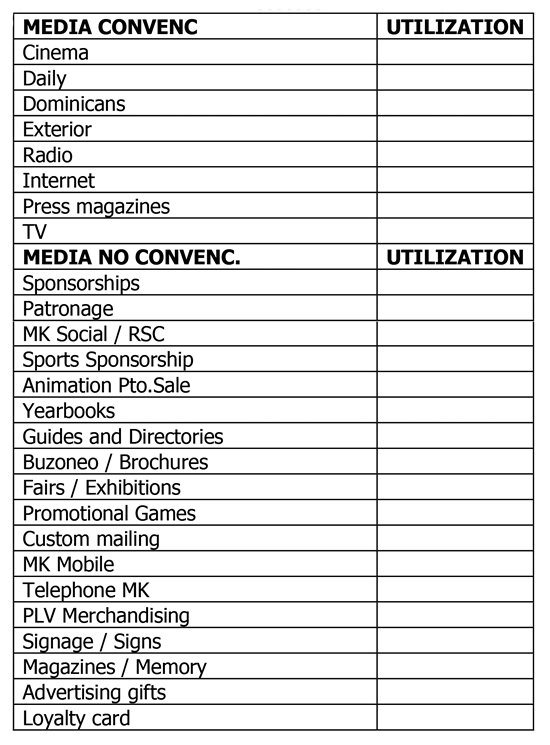
http://doi.org.10.15198/seeci.2018.45.55-73
RESEARCH
COMMUNICATION IN FOOD DISTRIBUTION COMPANIES IN SPAIN: AN ANALYSIS OF ONLINE AND OFFLINE
LA COMUNICACIÓN EN LAS EMPRESAS DE DISTRIBUCIÓN ALIMENTARIA EN ESPAÑA: UN ANÁLISIS DE LAS HERRAMIENTAS ONLINE Y OFFLINE
A COMUNICACAO NAS EMPRESAS DE DISTRIBUICAO ALIMENTÁRIA NA ESPANHA: UMA ANALISES DAS FERRAMENTAS ONLINE E OFFLINE
Pedro Pablo Marín Dueñas1
Assistant Professor Doctor in the Marketing and Communication Department of the University of Cádiz. Spain
Juan José Mier-Terán Franco2
Professor of University in the Department of Marketing and Communication of the University of Cádiz. Spain
Jesús Lozano Fernández3
Master in Strategic Management and Innovation in Communication. Cadiz University. Spain
ABSTRACT
This research analyzes the communication developed by the four most important food distribution companies in Spain, according to their market share (Mercadona, Carrefour, Dia and Eroski). This research focuses on the study of the main tolos (online and offline) that implement in their communication strategies, which an interesting study for both the Marketing and communication areas. Also for those responsible for developing new tools, searching for new processes that can be digitalized or sped up with new technologies, improving with products specific to said market. For the development of the same has been applied a mixed methodology, based on the technique of content analysis and observation. A series of tabs have developed that allow analysis to study in detail the different media that these organizations use to communicate with different audiences, with particular emphasis on the study of the websites and social networks that these companies have. The results show that Carrefour, Dia and Eroski develop similar communication strategies while Mercadona differs in the use of these tools.
KEY WORDS: Food distribution, Communication, Web, Social Networks, Conventional media, Content analysis, Observation.
RESUMEN
La investigación que se presenta analiza la comunicación que desarrollan las cuatro compañías de distribución alimentaria más importantes en España, en función de su cuota de mercado (Mercadona, Carrefour, DIA y Eroski) y, específicamente, se centra en el estudio de las principales herramientas que implementan en sus estrategias comunicativas, tanto a nivel offline como online, cuya interacción es un objeto de estudio de inherente interés en el campo tanto del marketing como de la comunicación. También resulta potencialmente llamativo para los responsables de crear nuevas herramientas online, a fin de identificar nuevos procesos que puedan digitalizarse o mejorarse mediante las nuevas tecnologías; y para mejorar las herramientas existentes con productos destinados a este sector específico del mercado. Para el desarrollo de la misma se ha aplicado una metodología mixta, fundamentada en la técnica del análisis de contenido y de la observación. Se han elaborado una serie de fichas de análisis que han permitido estudiar en profundidad los distintos medios de comunicación que estas organizaciones emplean para ponerse en contacto con sus distintos públicos, haciendo especial hincapié en el estudio de las webs y las redes sociales con las que estas empresas cuentan. De los resultados se desprende que Carrefour, DIA y Eroski siguen estrategias comunicativas parecidas mientras que Mercadona se diferencia en el uso que hace de dichas herramientas.
PALABRAS CLAVE: Distribución alimentaria, Comunicación, Web, Redes Sociales, Medios convencionales, Análisis de contenido, Observación.
RESUME
A investigação que se apresenta analisa a comunicação que desenvolvem as quatro companhias de distribuição alimentaria mais importantes na Espanha, em função de sua quota de mercado (Mercadona, Carrefour, DIA y Eroski) e, especificamente, centra-se no estudo das principais ferramentas que implementam em suas estratégias comunicativas, tanto a nível off-line como online. Para o desenvolvimento da mesma, foi aplicado uma metodologia mista, fundamentada na técnica da analises de conteúdo e da observação. Foram elaborados uma serie de fichas de analises que permitiram estudar em profundidade os distintos meios de comunicação que estas empresas empregam para se pôr em contato com seus distintos públicos, fazendo um especial destaque no estudo das webs e as redes sociais com as que estas empresas contam. Dos resultados se desprende que Carrefour, DIA, e Eroski seguem estratégias comunicativas parecidas enquanto Mercadona se diferencia no uso que faz destas ferramentas.
PALAVRAS CHAVE: Distribuição alimentaria, Comunicação, Web, Redes Sociais, Meios convencionais, Analises de conteúdo, Observação
Received: 20/09/2017
Accepted: 14/10/2017
Published: 15/03/2018
Correspondencia: Pedro Pablo Marín Dueñas
pablo.marin@uca.es
Juan José Mier-Terán Franco
juanjose.mier-teran@uca.es
Jesús Lozano Fernández
jesusfpo@gmail.com
1. INTRODUCTION
The universe of food distribution in Spain is characterized by strong competitiveness. An increasing concentration on the part of the big chains (together, the six main distribution groups of our country concentrate 53.7% of the market according to the report Kantarworldpanel 2016) together with the existence of regional operators and a large group of small local chains explain this situation. A more in-depth analysis of the sector, based on the data provided by the KantarWorldpanel study, which analyzes the 12-week period from 12/05/2016 to 02/26/2017, shows that Mercadona, with a 22.8 % share, is the market leader followed by Carrefour (8.6%); Day (8%), Eroski (5.7%) and Lidl (4.2%). As for the rest of the modern distribution, the evolution of regional supermarkets stands out once again. Establishments such as Consum, Ahorramas, Gadisa or Bon Preu stand out in the growth of the last quarter analyzed in said panel. The German Aldi also continues its good line of 2016 and is placed at the top of distributors in terms of growth and customer acquisition.
Another important phenomenon that is characterizing this sector is the growth of e-commerce. The large distributors are aware of the importance of this sales channel and continue to increase their commitment to the development of this sales platform which, during 2016, grew 24.5%.
In short, food distribution as a strategic sector in the Spanish market marked by the high competitiveness that characterizes it will continue to commit itself to the improvement and opening of establishments to gain quota and weekly buyers, while not losing sight of the growth of the online channel, precisely the channel that can stop in the medium term this tendency to invest continuously in the physical store. In this highly competitive environment, companies in the sector are struggling not to lose their market share by adapting to new purchasing habits, seeking closeness with customers, giving prominence to perishable products and launching their digital strategy.
In this context, the external communication that these companies develop will play a key role when it comes to positioning themselves in the market and reaching their strategic objectives, so it is configured as a tool that cannot be ignored. That is why this piece of research is proposed, which analyzes the communication that the main companies in the food distribution sector in Spain implement and, within them, delves into the digital communication activities they put into practice to reach their different audiences.
1.1 The communication of companies
As Villafañe (2004) points out, traditionally the communication of companies was explained, almost exclusively, from informative relations and Marketing or product communication.
This situation continued until the beginning of the nineties. The crisis in the advertising sector undergone in Europe (which called into question its effectiveness), the progressive fragmentation of audiences overcoming the traditional criteria of market segmentation, the loss of effectiveness of product communication, the homogenization of brands, and the emergence of a market dominated by competition and globalization, as a consequence of the processes of deregulation and privatization, causes companies and organizations to become aware of a new environment and a new reality to which one must be adjusted and adapted.
If we add to this the orientation of companies towards services to the detriment of what is material and tangible, we also find another cause that leads to a new redefinition of communication in the company (García, 2009). The communicative activity of the organizations has shifted from product communication to brand communication and, finally, to communication aimed at strengthening the image and reputation of the companies themselves (Villafañe, 2005). Companies change their perspective of what their communication should be, concepts such as corporate identity, image and reputation strongly emerging: the emergence of business intangibles is born (Villafañe, 2012).
Companies are no longer good with a good product communication to be competitive and, not only that, but they can no longer remain isolated. They need to relate to their audiences to create and maintain a climate of sympathy and understanding about “their demands and aspirations” (Carrillo and Castillo, 2007). It is essential, therefore, to empower the company itself. In this sense, the center of communication activities of an organization becomes the company itself.
Social changes, the opening of markets, globalization, the search for quality, extreme competitiveness or the current economic crisis are some of the challenges that business organizations have to face regardless of size. To respond to these demands, companies must implement new tools and strategies that allow them to compete with guarantees of success.
Given the difficult general economic situation, organizations are going through a period of difficulties and changes, which is why it is a propitious moment for them to rethink their business strategies and structures, looking for new forms of management that can differentiate them and make them more profitable. In this sense, the generation of value, based on business communication, now acquires prominent relevance in business management models.
This new model in business organizations, therefore, places communication in a strategic place. As Villafañe states (2007, p. 197) “during the nineties, there is a strong revaluation of the corporate image and the management model that makes it possible is comprehensive communication”. López (2003) considers that strategic management of all the intangibles of a company implies integrated management of image and communication assets: corporate, marketing and internal.
Spanish companies, subject to the demands of an increasingly demanding market and greater competitive pressure, have understood that, beyond economic results, image and communication are key to favoring their situation in the markets. The importance of this, as a strategic element for companies, although it is something recent for Spanish companies, is increasingly assumed. The 21st century has brought new challenges for companies at a general level. They are immersed in a stage in which uncertainty is the common denominator. Globalization is in a very advanced state and markets are increasingly changing and are influenced by external factors that are difficult for companies to control.
Communication, therefore, must become one of the fundamental pillars of the company, a basic resource for the operation of any entity. The problem is that, on many occasions, this function is given little importance by organizations.
To Stanton (1989), all companies, regardless of their size, products or services produced and geographical situation, must communicate to survive. Today, communication has become an indispensable condition to achieve a favorable position in society and achieve business success. Although this need of the organizations to communicate is as old as their existence, at present new demands by society, new audiences and interlocutors have appeared, who in turn are more and more numerous and are better informed, and, of course, a larger number of media and channels that force companies to place communication as one of the strategic axes in their management.
The future of the Spanish company, faced with great competition and a very changing environment, will depend to a large extent on its capacity of strategic management in general and, more specifically, on its capacity to manage its communication.
1.2. Organizations and digital communication
The increase in the use of New Technologies by today’s society contributes to increase the effectiveness of online communication tools used by organizations when allowing a bidirectional relationship with consumers, promoting a better relationship between the organization and its target audience. Companies cannot, and should not, ignore this new reality, which imposes new forms, different from those used until now and in which the role between sender and receiver is exchanged. The Internet has shaken the foundations of companies, reorienting even some principles of business strategy (De Chernatony, 2001).
The communication of the organizations has evolved in parallel to society and technology, in order to achieve the interests of the organizations in the context in which they develop their activity.
To Canals, the emergence of the Internet and the revolution that it has meant for companies is comparable to the industrial revolutions that have developed throughout the history of mankind.
The first industrial revolution meant a transformation and improvement in the production of goods. The second industrial revolution added to that transformation a radical change in transport and, eventually, in the forms of distribution. The Internet revolution is assuming a reconfiguration of companies-clients-suppliers relationships and, therefore, requires a change in the strategy and organization of companies (Canals, 2001, p. 61).
In the specific case of the Internet, with the Web as the greatest exponent, the world society experiences a commercial and economic revolution, because they bring with them a global, accessible and universal infrastructure and business organizations do not escape such benefits.
In addition, all these advances, although being expensive at the beginning, have achieved the reduction in the price of the processes, both production and transmission of messages. It cannot be denied that NTICS, in constant progress, have meant the evolution of the companies in terms of their processes. And the Web, specifically, has long ago generated positive transformations in organizations, producing important changes in traditional business models, which are radically changing the business landscape, in general, and that of business communication in particular. It can be seen how the relationship between a company and its corresponding public is changing in recent years, due to the new possibilities that the medium offers.
Web 2.0 not only allows you to buy and sell products and services over the network, but also involves new communication strategies to interact with the public. “The impact of the Internet in the world of the company goes beyond the offer of new products or services to become a type of technology that allows the creation of new business concepts” (Canals, 2001, p. 64) and that, in addition, “has revolutionized the forms of communication between companies and publics” (García, 2012, p. 140).
The effect that Web 2.0 has caused in the world of business communication is beyond doubt changing the communication strategies of many organizations. And others, who previously did not have it, begin to worry about them. The importance of the new medium has to make managers and owners worry about implementing communicative actions through the online media
The need to differentiate the company requires a strategy of image and communication in Web 2.0 that highlights the efforts of companies to integrate their audiences in it. Companies need to have both Web pages and profiles on social networks that are effective in allowing communication with those audiences.
Given the current competitive structure of the market, companies need to adapt to new technologies and the arrival of what is known as Web 2.0 has provided them with a new tool to value their advantages and strengths, enabling them to overcome the obstacles imposed by markets and allowing them to communicate and interact with their stakeholders.
In this sense, companies have been able to give the Web the importance it deserves, giving them more attention and proliferating the number of them that develop communication strategies through online channels.
2. OBJECTIVES
The object of study of this piece of research is the companies of food distribution that develop their activity in Spain and, specifically, the activities of communication they carry out to relate with their public.
Starting from this main axis, a series of primary objectives have been proposed, which, in turn, are composed of a series of secondary objectives that complement and give substance to the former. Specifically, they are:
Know and analyze the communication tools used by food distribution companies in Spain
Analyze the communication made by Spanish food distribution companies through the Internet.
Analyze the presence and use of social networks by food distribution companies
Analyze the websites of food distribution companies
3. METHODOLOGY
The methodology that has been implemented to achieve the research objectives proposed in this paper has been of a mixed type, applying both quantitative and qualitative techniques. The use of a combination of these methodologies will contribute to mitigate, to some extent, the limitations of each of them used independently. Following Vasilachis (2006, p. 67), “any piece of research or application of a scientific nature in the social sciences, as in sciences in general, must involve the use of rigorous, well-defined, transferable operative procedures susceptible to being applied again in the same conditions, adapted to the phenomenon to be discussed “. These will include:
3.1. Observation
Throughout this paper, observation has been raised as a systematic, conscious, planned and objective process. Thanks to this technique, primary information about our object of study is obtained. As García Ferrando (2015, p. 73) points out, “to observe is to put oneself in front of an object, at the same time as a slave to be faithful to it; and as a teacher to own or keep it. It is the method by which a concrete and intensive relationship is established between the researcher and the social fact or the social actors, from which data are obtained that are then synthesized to develop research”.
For the development of this methodological technique, an analysis sheet has been drawn up (see table 1) based on the classification carried out by the Infoadex organization, which broadly distinguishes between conventional media and unconventional media. Once this analysis template has been validated, all types of materials and documents related to the object of study, viewing and listening to media such as press, television, radio, internet and external, as well as direct observation of a series of points of sale have been reviewed.
Table 1. Analysis sheet for the study of the means of communication used.

Source: Own elaboration from Infoadex
3.2. Content analysis
It is a technique that allows interpretation and obtainment of conclusions about texts, images or other different forms where all kinds of data records, transcription of interviews, speeches, observation protocols or documents may exist. Berelson (1952, p. 103) defines content analysis as “a research technique for the objective, systematic and quantitative description of the manifest content of communication”. To Clemente and Santalla (1991, p. 56), it is “a technique for collecting information that allows you to transform a document into a series of quantitative and numerical results, from which the researcher can perform certain mathematical analyzes, whether statistical or not”.
This methodology has been applied on two different supports, the analysis of web pages on the one hand and that of social networks on the other hand. Based on this consideration, two self-made analysis cards have been designed.
The first of them is applied to the analysis of corporate websites and is theoretically based on the works of Martínez-Martínez, Saco-Vázquez and Fernández-Rodríguez (2008) and Marín, Lasso de la Vega and Mier-Terán (2015). Four study variables have been determined (Navigability, Organization, Legibility and Purchase Process) that have been measured based on the presence or absence of 19 specific items that can be seen in table 2.
In addition to this analysis, the Alexa Web analysis tool has been applied, which produces a global ranking that measures the position of the Web based on the indicators shown in table 3.
Table 2. Analysis sheet for the corporate website
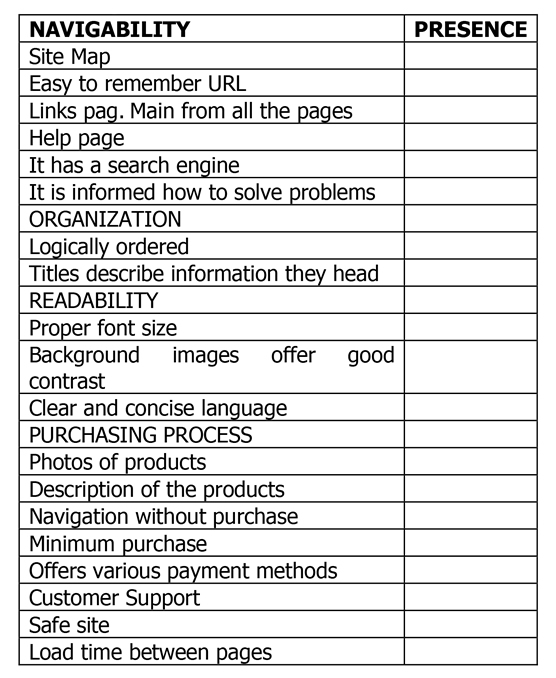
Source: Own elaboration
Table 3. Web Ranking
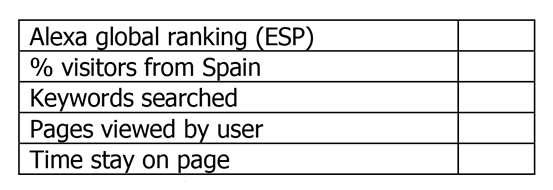
Source: Own elaboration from Alexa
As a theoretical basis for carrying out the analysis of the different social networks, a second analysis sheet has been designed (table 4) based on the work of Fondevila, Del Olmo and Bravo (2012). We will analyze, specifically, the average number of followers, the quality of the images, the periodicity with which materials are uploaded, the type of content and whether or not they allow dialogue and interaction with customers for each of the social networks in which organizations have a presence.
Table 4. Analysis sheet for the study of social networks
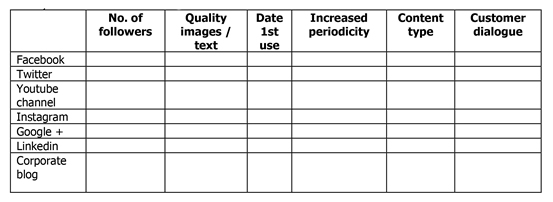
Source: Own elaboration
The final sample that has been analyzed is made up of the four food distribution companies with the largest market share according to the KantarWorldPanel 2016 study, these being: Mercadona, Carrefour, Eroski and DIA.
4. DISCUSSION
4.1 Communication tools used by food distribution companies in Spain
Table 5. Communication tools used
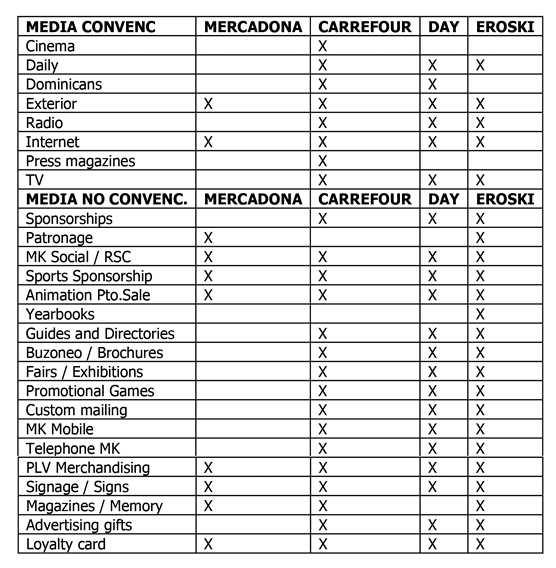
Source: Own elaboration
As can be seen in the comparative table that is attached, as regards the so-called conventional media, it can be observed that Mercadona is the only company that dispenses with the use of the two main and most popular media: Television and Radio. The rest, except for small exceptions or nuances, usually use all the conventional media available. The use of the Internet medium by all companies stands out too. Outdoor advertising, and more specifically signage billboards, is used by all companies, which use them in different sizes depending on the location of the point of sale referred to. In addition to billboards or monopoles, Mercadona uses canopies located in urban bus or train stops always near the point of sale. The rest also use canopies but regardless of the proximity of the point of sale.
With regard to non-conventional media, it can be seen how the four distribution companies we studied coincide. Even so, Mercadona is still the one that uses fewer tools than the rest. It is quite significant how they all use Patronage one way or another. Particularly significant is the way in which Mercadona does it. The name of the company does not appear in any of these sponsorships, assignments or donations. The name of one of its related foundations created to use usually appears, such as the Trinidad Alfonso Foundation or the sponsorship of the Valencia Basketball Club of the ACB League through the appearance of the slogan Culture of Effort on its shirt. Regarding participation in fairs and exhibitions, except Mercadona, all participate in thematic fairs on food. Neither does Mercadona use promotional or point games that are later exchanged for discounts on purchase. In this section, DIA and Carrefour are the ones that tend to do it more frequently. Carrefour has a series of exclusive discount cards for customers over 65 years of age with which they are applied a discount of the value of VAT on the products of butchery and charcuterie.
It is very common for food distribution companies to use door-to-door delivery as a tool. The different and varied offers that are promoted tend to transfer them to citizens this way. As you can see, all the companies use it fairly, except Mercadona, which does not usually use it even at the opening of a new point of sale. However, all the analyzed companies use and promote their loyalty card, using them practically the same way. With the exception of Mercadona, which uses them only to finance purchases and defer payments, the rest make use of them to offer discounts, promotions and fuel discounts thanks to the fact that they have service stations in most of their establishments.
4.2 Analysis of the websites of the main food distribution companies in Spain
Table 6. Web analysis
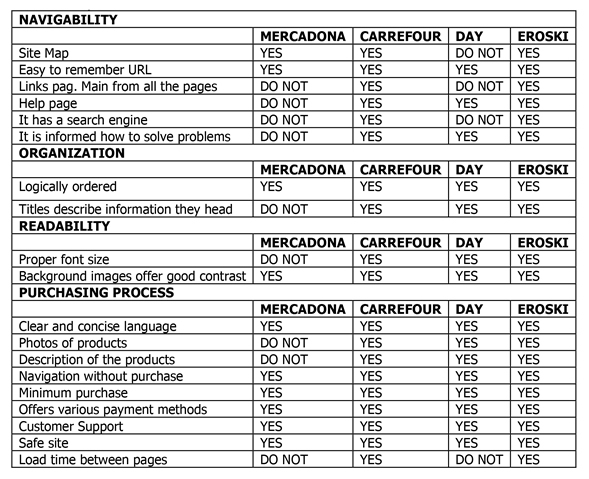
Source: Own elaboration
Table 7. Alexa analysis

Source: Own elaboration
From the analysis of the websites of the studied companies, it can be deduced that, with the exception of Mercadona, the rest of the competitors have modern, versatile and advanced websites. The sites Carrefour, DIA and Eroski denote good management of this online tool: these are websites with a high degree of utility, great ease of use and where the use of photographs and information of interest stands out. In the case of the Mercadona website, its design is obsolete and quite austere, typical of a website from the beginning of the nineties.
On the other hand, only Carrefour and Eroski incorporate a search engine within the web, which makes the user’s experience much easier. Regarding readability, font sizes and illustrations are adequate and use a simple and clear language for the client. The descriptions of the products are usually extensive, understandable and functional for the visitor, something that does not happen with the Mercadona website: it is conspicuous that no photographs or detailed descriptions appear, except for its own brands, for the products. The typography used is difficult to read, complicating the purchase process.
The fact that all the analyzed pages offer the possibility of making the purchase online as well as the existence of various payment methods within secure platforms for the user stands out. With the exception of Mercadona, all companies include information on offers and / or occasional rebates.
Regarding the data collected from Alexa on the positioning of the web in Spain, it can be said that Carrefour has the best results in this regard, being positioned in our country in place 153 among the most visited websites. Users of this website usually spend about 5.05 minutes there on average and navigate around 5.45 pages or sections within it. The data on both DÍA and Eroski are much more discreet as they occupy positions 1,230 and 2,434 respectively in the national ranking. With regard to Mercadona, this global ranking of visits places its website at 927, with an average stay on the page per visit of 4.17 minutes and views of 4.1 pages or sections per visitor. Despite not being a simple and practical website for the client, the position it occupies in the ranking is quite good, perhaps obtained thanks to the popularity of the company in terms of direct sales and the quality of its own brands that it markets in its physical sales points. Of the other three websites, taking into account the collected and analyzed data, DIA website is the least functional, probably due to the fact that it was the last one to join the online sale. However, it has a more careful, modern and useful design than that of Mercadona, which is undoubtedly the one that has more deficiencies than all the analyzed ones.
4.3 Analysis of the presence and use of social networks of the main food distribution companies in Spain
Table 8. Analysis of social networks Mercadona.
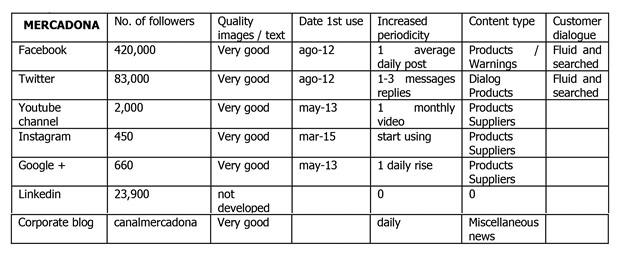
Source: Own elaboration
Table 9. Social networks analysis Carrefour
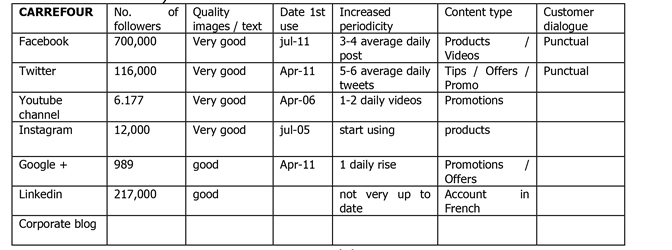
Source: Own elaboration
Table 10. Analysis of DIA social networks
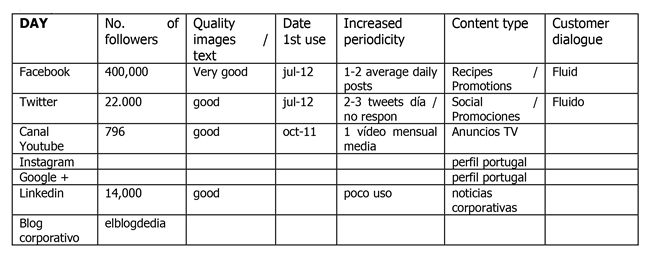
Source: Own elaboration
Table 11. Analysis of Eroski social networks
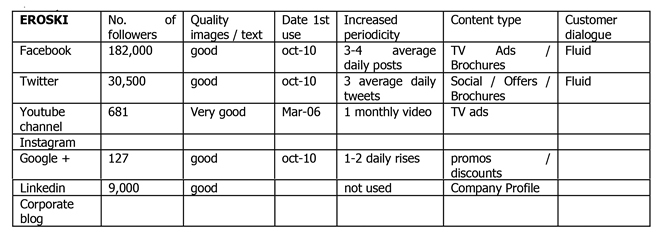
Source: Own elaboration
It is observed how, in general, all the organizations are present in the main digital social networks. Analyzing aspects such as the creation and incorporation to them, it can be said that all the organizations started their trajectory in networks practically at the same time, from which it could be inferred that there is a thorough surveillance of the strategies used by the competition at all times, as well as the importance that social networks offer them for the development of a communicative strategy in the online environment. Even so, Eroski is the first organization that decides to join both Facebook and Twitter. Despite this, it is the one with fewest followers in these social networks.
With regard to monitoring, the data resemble, curiously, those who offer us the annual sales quotas of the studied organizations or companies. That is to say, Carrefour Spain stands out from the rest with more than 300,000 followers or fans of its Facebook pages.
However, there are some differences and nuances regarding the way of use carried out by each one of them. Although the information that all offer could be cataloged as ample and sufficient, the periodicity of the actions, as well as the updating of their contents are different, there are small nuances that should be highlighted. DIA España is the one most committed to the rise of daily posts. Normally, on average, it usually publishes from four to five a day. Carrefour España, Eroski and Mercadona publish around two tickets a day coinciding, normally, with the morning and afternoon hours. In addition to publishing the posts with their own content, all tend to respond to the interactions they receive from followers, responding to all doubts, complaints and claims by customers quickly, cordially and assertively and sometimes even ironically and with a sense of humor. What is clear is that interactions with consumers are very professional. On the other hand, the entries of all organizations usually have a very large number of “likes”, a sign of the loyalty of the followers of the organization. The contents that the different organizations usually upload come from a common root - the promotion of their products - making known the assortment as well as the main current promotions. All, except Carrefour España that focuses on the promotion of products with manufacturer’s brand, usually promote products of their own distributor brands (DIA, Eroski, Mercadona). With regard to the quality of the entries, it can be said that these are works that are fairly well done and taken care of as regards the visual image and the preparation and writing of the contents, so that it can be concluded that all of them allocate sufficient resources and pamper their presence in the networks since they consider that they are a key tool within their global strategy.
Twitter is the other social network m fans but they mention mencide that umidores are very professional. It aims to achieve the objectives of the different technologies: still used by the different organizations. It seems that the fact that one of them begins to use it is what has awakened the rest to get on the car of 140 characters. As happens on Facebook, the two companies with the largest market share, Carrefour Spain and Mercadona - in this order – are the ones with the largest number of followers. From the analysis of their publications, it can be seen that their tweets are constant and even repetitive and are usually based, mainly, on answering questions, queries and suggestions from followers. The rest of the organizations, which also respond kindly to their followers, are dedicated to tweeting different types of offers, products and promotions to try to attract the customer towards the purchase. All, in addition, usually use the retweet option, although this is usually accompanied by a prior explanation. These retweets, in most cases, are not usually about fan entries but make mention of the companies that manufacture the products that are usually distributed and that are present in the normal assortment of each surface. The quality of the published content, despite the limitations of this network, is quite good and cared for. At all times, a totally assertive tone is manifested, a fact that denotes the importance that - equally - is given to this medium within its online communication strategy.
With regard to other social networks, it can be said that they are not used so regularly by these companies, perhaps due to the specific target which they tend to address. Linkedin, for example, a social network that is dedicated to establish contacts among professionals and is mainly dedicated to employment, noted for its non-presence within the network strategy of these organizations. Carrefour, at a European level, uses it mainly to search for future employees, constantly offering job offers within its diverse and varied areas. The use that the rest make of this tool is sporadic, which is practically not updated, which materializes in a much smaller number of followers, Carrefour standing out in this sense with 217,000. On the other hand, it is noteworthy that two of the companies (DIA and Eroski) do not have at the time of the study an open account in one of the fastest growing social networks in recent years as Instagram. Of the other two, although Mercadona does have an account, it has few followers and Carrefour seems to be the one that makes the most use of it, although both seem to be in the initial stage of development. For its part, Google + is a network that is in a very embryonic phase and that is noticeable in the use that these companies make in their digital communication.
5. CONCLUSIONS
With regard to the communication tools used by Spanish distribution companies, Mercadona uses mainly non-conventional communication tools, unlike its competitors (Carrefour, DIA and Eroski), which use both conventional and non-conventional media. This is because Mercadona does not use commercial communication properly speaking. Its philosophy is not to contact the population through the mass media but rather the company aims to reach the customer in the way a typical neighborhood store has done so far: with quality products, proximity to home, and that the seller is a prescriber of brands, close and friendly.
Regarding the use of social networks, they are all present in the main ones and make efficient use of them. Among the main characteristics of the use made of them is the quality of the published images and texts, as well as the fluidity of the process of interaction with the client, which, at all times, is continuous, professional and systematic. Regarding the strategy followed by the companies in these networks, while Mercadona bases its communication on the corporate rather than on the commercial aspects such as the manufacturing processes, the denominations of origin of its products or the contribution of the company to the improvement of the environment and its contribution for social purposes.
The rest do use networks for the commercial promotion of their products, including features and prices, the latter aspect is never practiced by Mercadona.
From a more quantitative point of view, Carrefour is the one with the greatest follow-up on social networks, with 700,000 followers on Facebook and 116.00 on Twitter, as compared to Mercadona with 420,000 and 82,000, for example.
As for the web study, the corporate sites of Carrefour, DIA and Eroski are much better designed and have better management than Mercadona. Their ease of use, as well as their appearance, much more current, with an attractive and functional design, stand out. Their contents, apart from also focusing on the company and its characteristics, are based on products, their characteristics and prices. They include offers and promotions of various products and services offered by these companies, unlike Mercadona, which does not include these types of themes on its website. The online sales platforms of these websites, with the exception of DIA, are platforms in which ease of use, as well as versatility, stand out above all else. The Mercadona website, on the other hand, is a simple and austere page in terms of illustrations, functionality and content. It focuses primarily on the company, its contribution to society and the importance within the sector in Spain. As regards the online shopping platform, its difficulty of use is remarkable. Lack of updating and improvements on the web are symptoms of not committing itself, at least for the moment, to this sales channel.
By way of conclusion and summary, Mercadona differs from its main competitors in not using, preferably, commercial communication and more frequently using corporate communication, using mainly the so-called non-conventional or non-massive tools. While its competitors strive to publicize their prices, offers, promotions, discounts and products, the data observed and collected in this study indicate that Mercadona prefers its image, its own products and its way of doing things to reach the public through face to face with the client so that, this way, the purchase becomes a pleasant experience.
It is significant to note that, like its competitors, Mercadona also uses the web and social networks within its global communication strategy, but with the nuance that it never does so to promote products or prices, only and in a very convenient way, it promotes temporary releases and never promotes prices. Most of Mercadona’s publications through social networks are based on aspects related to product production processes, appellations of origin and clarification of issues that have previously been filtered by the same networks in a malicious way. The fact that the online shopping process is not offered a better infrastructure denotes that Mercadona advocates for the client to visit the establishment and be the one to check the facilities and services that the company offers, as it comes out of the observed data.
6. REFERENCES
1. Berelson, B. (1952). Content Analysis in Communication Researches. Glencoe III: Free Press.
2. Canals, J (2001). La estrategia de la empresa en la era de Internet. Información Comercial Española, 793.
3. Clemente, M. & Santalla. Z. (1991). El Documento Persuasivo: Análisis de Contenido y Publicidad. Bilbao: Deusto.
4. Carrillo, M.V. & Castillo, A. (2007). El desarrollo de las estrategias de comunicación y de imagen en las PYMES. El caso de Extremadura. Fisec Estrategias, 6(7), 3-22.
5. De Chernatony, L. (2001). Succeeding with brands on the Internet. Journal of Brand Management, 8(3), 186-95.
6. Fondevila, J. F.; Del Olmo, J. L. & Bravo, V. (2012). Presencia y reputación digital en “social media”: comparativa en el sector de la moda. Fonseca. Journal of Communication, 5, 92-116.
7. García, B. (2009). Gabinetes de comunicación online: claves para generar información corporativa en la red. Comunicación Social, 28.
8. García, M. (2012). La comunicación de la marca en las pymes a través de sus sedes webs. El caso de las pymes extremeñas. El caso de las PYMES extremeñas. Tesis doctoral. Universidad de Extremadura.
9. García, M. (2015). El análisis de la realidad social: Métodos y técnicas de investigación. Madrid: Alianza Editorial.
10. López, I. (2003). Observatorio permanente del corporate. Informe sobre el estado actual de la publicidad y el Corporate en España y Latinoamérica. Madrid: Pirámide.
11. Marín, P.P.; Lasso de la Vega, C. & Mier-Terán, J.J. (2015). La interactividad de las webs en las pequeñas y medianas empresas. Opción, 31(3), 735-750.
12. Martínez Martínez, M.; Saco Vázquez, M. & Fernández Rodríguez, R. (2008). Estudio comparativo de los supermercados online españoles. Análisis de contenido de los sitios web. EsicMarket, 131, 121-145.
13. Stanton, N. (1989). Las técnicas de comunicación en la empresa. Bilbao: Ediciones Deusto.
14. Vasilachis, I. (2006). Estrategias de investigación cualitativa. Barcelona: Gedisa Editorial.
15. Villafañe, J. (2004). La buena reputación. Claves del valor intangible de las empresas. Madrid: Pirámide
16. Villafañe, J. (2005). La gestión de los intangibles empresariales. Comunicação e Sociedade, 8, 101-113.
17. Villafañe, J. (2007). Informe anual. La comunicación empresarial y la gestión de los intangibles en España y Latinoamérica. España: Pearson Prentice Hall.
18. Villafañe, J. (2012). La gestión profesional de la imagen corporativa. Madrid: Pirámide.
19. Villafañe, J. (2004). La buena reputación. Claves del valor intangible de las empresas. Madrid: Pirámide
20. Villafañe, J. (2005). La gestión de los intangibles empresariales. Comunicação e Sociedade, 8, 101-113.
21. Villafañe, J. (2007). Informe anual. La comunicación empresarial y la gestión de los intangibles en España y Latinoamérica. España: Pearson Prentice Hall.
22. Villafañe, J. (2012). La gestión profesional de la imagen corporativa. Madrid: Pirámide.